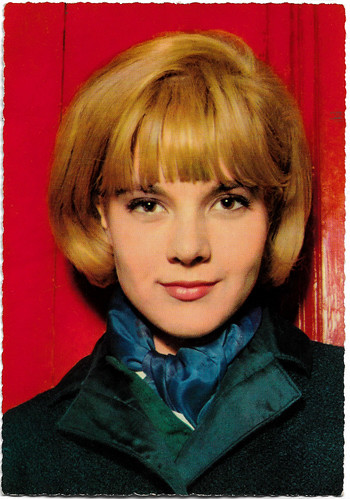
West-German postcard by Krüger, no. 902/267 Photo: Neuvecelle.
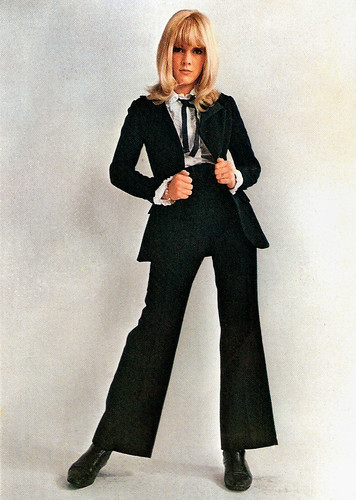
French postcard by E.D.U.G., no. 482. Photo: Jean Marie Perier.

French postcard by E.D.U.G., no. 507. Photo: Sam Lévin.
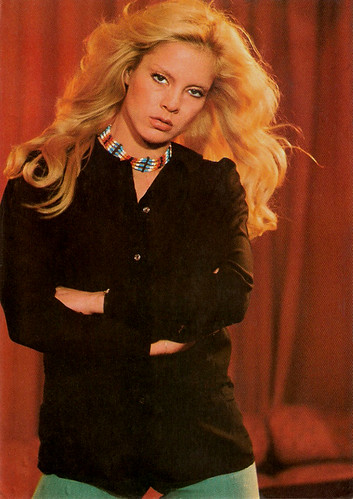
French postcard by Editions Lyna, Paris, no. 2051. Photo: Raymond Depardon / Gamma.
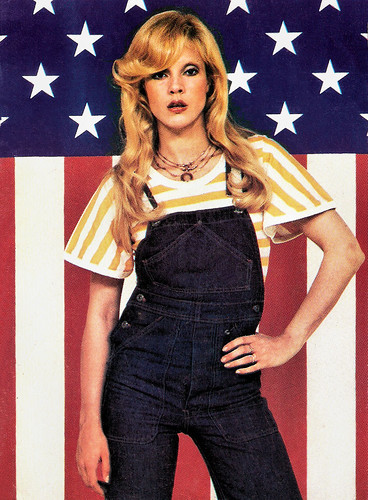
French promotion card by RCA.
The Twisting Schoolgirl
Sylvie Vartan was born in Iskretz near Sofia, Bulgaria. Her father, Georges Vartanian was a Bulgarian of Armenian descent. He worked as an attache at the French embassy in Sofia. Her mother, Illona Vartanian, was Hungarian.
In September 1944, when the Soviet Army occupied Bulgaria, the Vartan family house was nationalised and they moved to Sofia. A friend of father Georges offered Sylvie a role of a schoolgirl in his film Pod igoto/Under the Yoke (Dako Dakovski, 1952). The film was about Bulgarian rebels against the Turkish occupation. Being a part of the film had a lasting impression on her and made her dream of becoming an entertainer.
The family emigrated to Paris in December 1952. By the example of her brother, professional trumpeter and later artistic director at RCA records Eddie Vartan, teenage Sylvie's main interest was music. In 1961 Eddie offered Sylvie to record the song 'Panne d'essence' (Out of gas) with the French rocker Frankie Jordan. It was a surprise hit and provided her first appearance on French TV.
Journalists gave her the nickname "La lycéenne du twist". After "the Twisting Schoolgirl" had finished the Lycée Victor Hugo (Victor Hugo School), she signed a solo recording contract with RCA. Her first single 'Quand le film est triste', covering Sue Thompson's 'Sad movies' was a hit in December 1961.
Soon followed more hits like her version of 'The Loco-Motion' and 'Tous mes copains'. Six of her thirty-one songs released in 1962 became top 20 hits in Europe. A small part as a singer in Un clair de lune à Maubeuge/Moonlight in Maubeuge (Jean Chérasse, 1962) starring Claude Brasseur was her first film appearance as an adult.
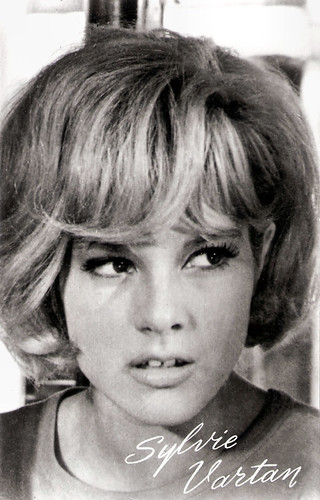
Dutch postcard by Muziek Parade, Hilversum, no. AX 5643.

French postcard by E.D.U.G. Publicity card for RCA Victor. Photo: Sam Lévin.
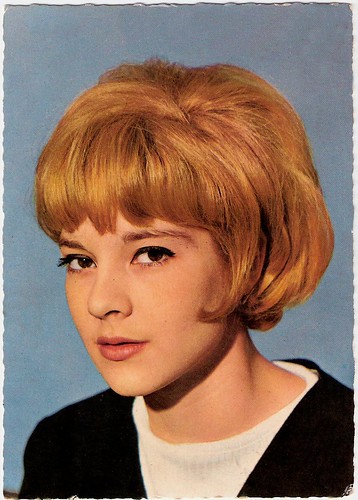
French postcard by Publistar, Marseille, no. 818. Photo: Spitzer.
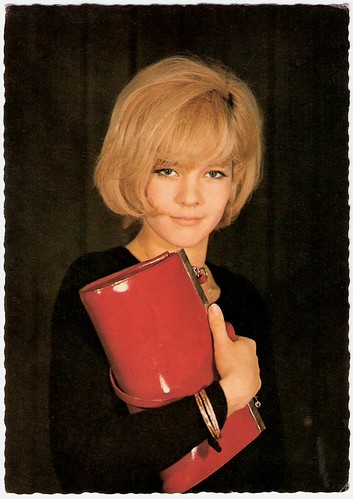
French postcard by Publistar, Marseille, no. 939. Photo: Patrick Bertrand.
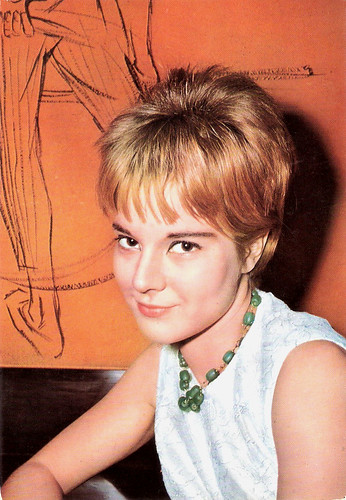
French postcard by Editions P.I., Paris, no. 1092. Photo: Anders.
Short Skirts, Barbarella Boots and the Beatles
In 1962 Sylvie Vartan met Jean-Philippe Smet, better known as Johnny Hallyday, during her second concert in the Olympia. In 1963, after announcing their engagement over the radio, the young couple performed to a noisy audience of 200,000 at La Nation square of Paris.
Sylvie and Johnny appeared together in the film D'où viens-tu, Johnny?/Where Are You From, Johnny? (Noël Howard, 1963). And that year she was voted top French singer in the first pole on the TV programme Salut les copains. The next year, she played a supporting role in the film Patate/Friend of the Family (Robert Thomas, 1964) opposite ;Jean Marais and Danielle Darrieux. Being accompanied by the film Cherchez l’idole/The Chase (Michel Boisrond, 1964) with Dany Saval, her song 'La plus belle pour aller danser' sold over a million copies in Japan.
In 1964 Sylvie shared the bill with the Beatles and Trini Lopez at the Olympia.
EFSP co-editor and Vartan fan Marlene Pilaete: "Bruno Coquatrix, Olympia’s owner, had decided to produce a show for teenagers. He chose the Beatles, Sylvie Vartan, and Trini Lopez to be the stars of his show. The show took place from the 16th of January to the 4th of February 1964, twice a day. In Coquatrix’s mind, the three stars were of equal importance and their billing on the programs and on Olympia’s marquee was identical. The same character size was used for the three. No name was in bigger letters than the others.
In the beginning, the order of appearance was this: first the Beatles, then Sylvie Vartan, then Trini Lopez. During the first performances, the Beatles were not badly received but their welcome was not as tremendous as it was in Great Britain. It was different from what they had experienced in their native country: there were no hysterical female fans shouting and crying.
But, as days went by, their success became more and more resounding. Coquatrix understood that the Beatles fans were not too happy to see their band sing a few songs and then be replaced by Sylvie Vartan. For Vartan, who was not yet twenty at the time, it was not easy to handle angry Beatles fans. So, Coquatrix decided to change the order of appearance after a few days: it became first Trini Lopez, then Sylvie Vartan, then the Beatles. But there was no change regarding the billing. The three names still appeared in the same size."
Sylvie made numerous US TV appearances and an international concert tour, including Canada, South America, and Japan. In 1965 Sylvie and Johnny were married in Loconville. They had a son David Michael Benjamin, known now as singer David Hallyday. In 1968 Sylvie suffered a traffic accident but was back on tour in August.
No longer a shy young yé-yé girl but a sexy dancer, more into cabaret than rock & roll. She appeared often on French and Italian TV, dressed in short skirts and Barbarella boots. In Italy, she had huge hits with 'Zum zum zum' in 1968 and 'Irrestibilmente' in 1969. She continued with intensive performing and recording.

French postcard by Encyclopédie du Cinéma, no. EDC 552 Vis. 6. Photo: Johnny Hallyday and Sylvie Vartan in D'où viens-tu... Johnny?/Where Are You From, Johnny? (Noël Howard, 1963).

French postcard by E.D.U.G., no. 329. Photo: Sam Lévin / RCA Victor.
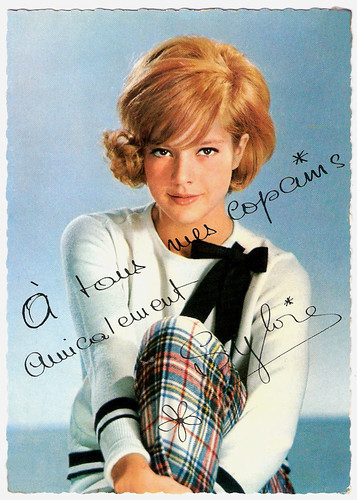
French postcard by E.D.U.G., no. 276. Offered by André. Photo: Sam Lévin.
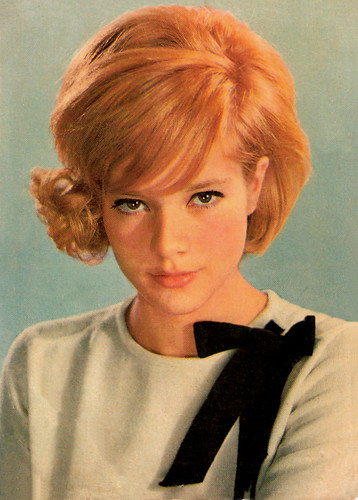
French postcard by E.D.U.G., no. 329. Photo: Sam Lévin / RCA Victor.

French postcard by Editions P.I., Paris, no. 1116. Photo: Kasparian.

French postcard by PSG, no. 453 Photo: Philippe d'Argence / RCA Victor.
Sylvie Vartan returned on the screen opposite Mathieu Carrière and Orson Welles in the cult film Malpertuis/The Legend of Doom House (1971, Harry Kümel). She also appeared in two documentaries by Francois Reichenbach, J’ai tout donné/I’ve given everything (1971) and Mon Amie Sylvie/My Friend Sylvie (1972).
Musically, she had a hit in 1976 with the John Kongos' cover 'Qu'est-ce qui fait pleurer les blondes?', topping the French charts for several weeks. She went disco with a single called 'Disco Queen' in 1978. Marlene Pilaete: "I’ve bought that single at the time and I still have it. But, contrary to her colleague Sheila, Vartan never really warmed to disco and her next two singles, 'Solitude' and 'Fantaisie', were not disco. She came back to disco once with 'I don’t want the night to end' in 1979 and then completely gave up that style of music. She never really had her disco era."
In 1980, after several widely publicised disagreements, Sylvie and Johnny finally divorced. After releasing 'Love again' in duet with John Denver, a #85 single on Billboard Hot 100 in 1984, Vartan took a break in show business. In 1990 she gave a concert at the Palace of Culture of Sofia, opening and closing with a Bulgarian song. This was her first visit to the city after her emigration.
After her brother Eddie died from a brain haemorrhage in 2001, she took another break in performing public. In the fall of 2004, she started recording and giving concerts of jazz ballads in French-speaking countries and Japan. Her last film appearances were in L’ange noir/The Black Angel (Jean-Claude Brisseau, 1994) with Michel Piccoli and Tchéky Karyo, and opposite Francis Huster in the TV film Mausolée pour une garce/Mausoleum for a Bitch (Arnaud Sélignac, 2001), adapted from a best-selling novel by Frédéric Dard.
Vartan celebrated her 60th birthday in style in 2004, publishing her autobiography, 'Entre ombre et lumière' (Between Shadow and Light), and releasing a brand new album, simply entitled 'Sylvie'. In the following years, several new albums and tours followed. In 2014 she returned to the screen in the French romantic comedy Tu veux ou tu veux pas/Sex, Love & Therapy (Tonie Marshall, 2014) starring Sophie Marceau and Patrick Bruel.
Since 1984, Sylvie Vartan is married to Italian-American producer Tony Scotti. They have adopted a young Bulgarian girl, Darina. Sylvie Vartan is an aunt to Eddie Vartan's son, actor Michael Vartan.

French postcard by E.D.U.G., no. 499 Photo: Jean-Marie Perier / RCA.
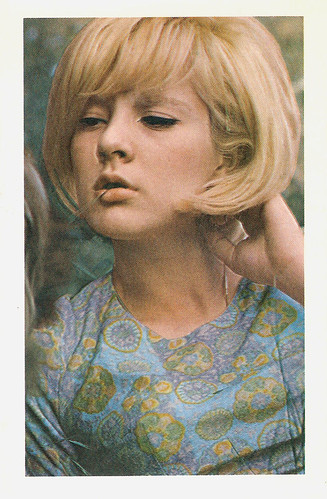
Vintage postcard.
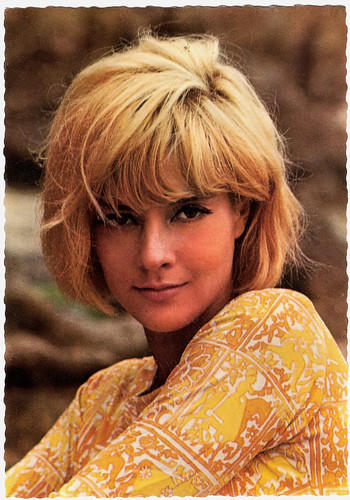
French postcard by E.D.U.G., no. 382. Photo: Philippe D'Argence.

French postcard by PSG, no. 1034. Photo: Laurent Camil / RCA Victor.

With Johnny Hallyday. French postcard by Carterie Artistique et Cinématographique, Pont du Casse, no. ST JH 13.
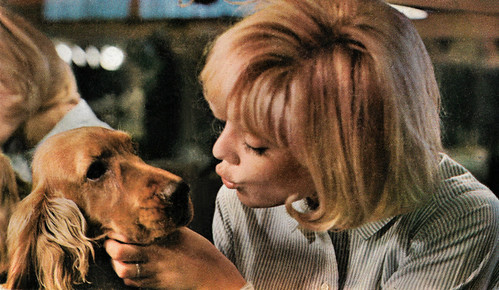
French postcard by PSG, offered by Corvisart, no. 1194 A. Photo: R. Kasparian / RCA.
Scopitone clip of Sylvie Vartan singing 'Est ce Que Tu Le Sais'. Source: Cheryl Lynn (YouTube).
Sylvie Vartan sings 'La plus belle pour aller danser' in Cherchez l'Idole (1964). Source: win081 (YouTube).
Trailer Malpertuis (1973). Source: Wim Baelus (YouTube).
Sylvie Vartan sings 'Déprime' in Cadence 3 (1983). Source: The Catrate (YouTube).
Sources: RFI Musique (French), Wikipedia, and IMDb.
In the beginning, the order of appearance was this: first the Beatles, then Sylvie Vartan, then Trini Lopez. During the first performances, the Beatles were not badly received but their welcome was not as tremendous as it was in Great Britain. It was different from what they had experienced in their native country: there were no hysterical female fans shouting and crying.
But, as days went by, their success became more and more resounding. Coquatrix understood that the Beatles fans were not too happy to see their band sing a few songs and then be replaced by Sylvie Vartan. For Vartan, who was not yet twenty at the time, it was not easy to handle angry Beatles fans. So, Coquatrix decided to change the order of appearance after a few days: it became first Trini Lopez, then Sylvie Vartan, then the Beatles. But there was no change regarding the billing. The three names still appeared in the same size."
Sylvie made numerous US TV appearances and an international concert tour, including Canada, South America, and Japan. In 1965 Sylvie and Johnny were married in Loconville. They had a son David Michael Benjamin, known now as singer David Hallyday. In 1968 Sylvie suffered a traffic accident but was back on tour in August.
No longer a shy young yé-yé girl but a sexy dancer, more into cabaret than rock & roll. She appeared often on French and Italian TV, dressed in short skirts and Barbarella boots. In Italy, she had huge hits with 'Zum zum zum' in 1968 and 'Irrestibilmente' in 1969. She continued with intensive performing and recording.

French postcard by Encyclopédie du Cinéma, no. EDC 552 Vis. 6. Photo: Johnny Hallyday and Sylvie Vartan in D'où viens-tu... Johnny?/Where Are You From, Johnny? (Noël Howard, 1963).

French postcard by E.D.U.G., no. 329. Photo: Sam Lévin / RCA Victor.

French postcard by E.D.U.G., no. 276. Offered by André. Photo: Sam Lévin.

French postcard by E.D.U.G., no. 329. Photo: Sam Lévin / RCA Victor.

French postcard by Editions P.I., Paris, no. 1116. Photo: Kasparian.

French postcard by PSG, no. 453 Photo: Philippe d'Argence / RCA Victor.
Going Disco
Sylvie Vartan returned on the screen opposite Mathieu Carrière and Orson Welles in the cult film Malpertuis/The Legend of Doom House (1971, Harry Kümel). She also appeared in two documentaries by Francois Reichenbach, J’ai tout donné/I’ve given everything (1971) and Mon Amie Sylvie/My Friend Sylvie (1972).
Musically, she had a hit in 1976 with the John Kongos' cover 'Qu'est-ce qui fait pleurer les blondes?', topping the French charts for several weeks. She went disco with a single called 'Disco Queen' in 1978. Marlene Pilaete: "I’ve bought that single at the time and I still have it. But, contrary to her colleague Sheila, Vartan never really warmed to disco and her next two singles, 'Solitude' and 'Fantaisie', were not disco. She came back to disco once with 'I don’t want the night to end' in 1979 and then completely gave up that style of music. She never really had her disco era."
In 1980, after several widely publicised disagreements, Sylvie and Johnny finally divorced. After releasing 'Love again' in duet with John Denver, a #85 single on Billboard Hot 100 in 1984, Vartan took a break in show business. In 1990 she gave a concert at the Palace of Culture of Sofia, opening and closing with a Bulgarian song. This was her first visit to the city after her emigration.
After her brother Eddie died from a brain haemorrhage in 2001, she took another break in performing public. In the fall of 2004, she started recording and giving concerts of jazz ballads in French-speaking countries and Japan. Her last film appearances were in L’ange noir/The Black Angel (Jean-Claude Brisseau, 1994) with Michel Piccoli and Tchéky Karyo, and opposite Francis Huster in the TV film Mausolée pour une garce/Mausoleum for a Bitch (Arnaud Sélignac, 2001), adapted from a best-selling novel by Frédéric Dard.
Vartan celebrated her 60th birthday in style in 2004, publishing her autobiography, 'Entre ombre et lumière' (Between Shadow and Light), and releasing a brand new album, simply entitled 'Sylvie'. In the following years, several new albums and tours followed. In 2014 she returned to the screen in the French romantic comedy Tu veux ou tu veux pas/Sex, Love & Therapy (Tonie Marshall, 2014) starring Sophie Marceau and Patrick Bruel.
Since 1984, Sylvie Vartan is married to Italian-American producer Tony Scotti. They have adopted a young Bulgarian girl, Darina. Sylvie Vartan is an aunt to Eddie Vartan's son, actor Michael Vartan.

French postcard by E.D.U.G., no. 499 Photo: Jean-Marie Perier / RCA.

Vintage postcard.

French postcard by E.D.U.G., no. 382. Photo: Philippe D'Argence.
French postcard by PSG, no. 1034. Photo: Laurent Camil / RCA Victor.

With Johnny Hallyday. French postcard by Carterie Artistique et Cinématographique, Pont du Casse, no. ST JH 13.

French postcard by PSG, offered by Corvisart, no. 1194 A. Photo: R. Kasparian / RCA.
Scopitone clip of Sylvie Vartan singing 'Est ce Que Tu Le Sais'. Source: Cheryl Lynn (YouTube).
Sylvie Vartan sings 'La plus belle pour aller danser' in Cherchez l'Idole (1964). Source: win081 (YouTube).
Trailer Malpertuis (1973). Source: Wim Baelus (YouTube).
Sylvie Vartan sings 'Déprime' in Cadence 3 (1983). Source: The Catrate (YouTube).
Sources: RFI Musique (French), Wikipedia, and IMDb.
10 comments:
Good morning! I'm going to read the post in its entirety tonight! I watched the locomotion video three times with my kids though! They wanted to watch it over and over. I have never heard the French version of this song. Fun!
I remember Syvie Vartan fairly clearly. That ages me! :)
I remember the name but dont think I had ever seen her in anything or heard her til now .. Happy Easter
It's refreshing to see someone who is older than me. Sweaters and A-line skirts -we would have looked like the Bobsey Twins in the 60's. The video's were fun to watch - thanks for another delightful and informative PFF!
Another fun history lesson! Loved the nick-name "Twisting Schoolgirl"... too funny! Hope your Easter is wonderful...
~blessings~
Pearl
Fun history lesson. I loved the Locomotion. What a riot!! I've got to find the song she sang w/John Denver. When I read that, I went "huh?"
Oh! When I was young, Sylvie was the idole of my mother (today again, I'm sure).
She's a star in France.
Happy PFF and happy Easter.
Thank you for your comments. Happy Easter everybody!
I remember her but I think that the new generation doesn't at all.
She doesn't appear anymore on our TV. Times have changed, as well as celebrities.
Have a nice week-end and Happy Easter.
Wonderful cards and complete information about Sylvie Vartan! She was very popular and loved in Turkey when I was a little girl.
Have a nice Sunday and a Happy Easter!
Post a Comment